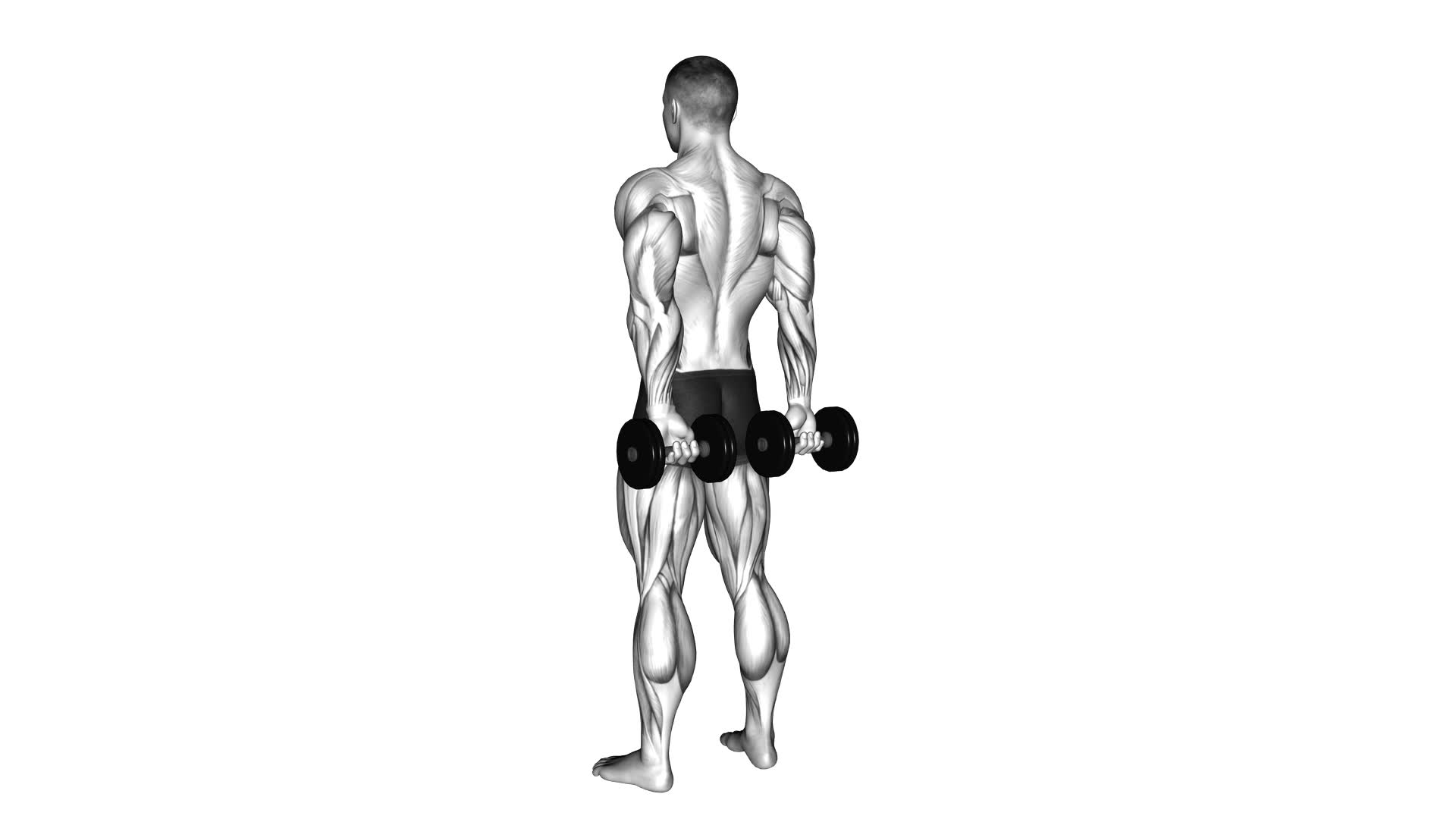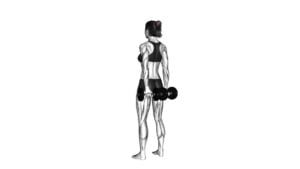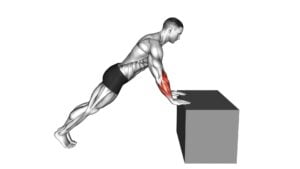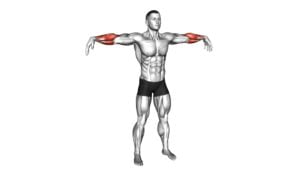Dumbbell Behind Back Finger Curl – Video Exercise Guide & Tips

Are you looking to strengthen your fingers and forearms? The Dumbbell Behind Back Finger Curl is a great exercise for you.
Watch This Exercise Video
By using a dumbbell and positioning it behind your back, you can target and engage the muscles in your fingers and forearms.
In this article, you will find a comprehensive video exercise guide and useful tips to ensure you perform this exercise with proper form and technique.
Get ready to improve your grip strength and enhance your overall upper body strength.
Key Takeaways
- Increased grip strength and forearm development
- Stabilizes wrists and reduces risk of sprains or strains
- Targets and strengthens muscles in the hands and wrists
- Enhances hand and finger dexterity
Benefits of the Dumbbell Behind Back Finger Curl
You'll experience increased grip strength and forearm development with the dumbbell behind your back finger curl. This exercise is a great way to target and strengthen the muscles in your hands and wrists, which can have a positive impact on your overall grip strength. By holding the dumbbell behind your back and curling your fingers towards your palm, you're engaging the muscles in your forearms, wrists, and fingers, resulting in increased strength and endurance.
Increased grip strength can be beneficial in many aspects of your daily life. It can improve your performance in activities that require a strong grip, such as weightlifting, rock climbing, or playing sports like tennis or golf. Additionally, having a strong grip can help prevent injuries, as it provides stability and control when handling heavy objects or performing tasks that involve gripping.
Furthermore, the dumbbell behind back finger curl can also help prevent injuries. Strengthening your grip muscles can stabilize your wrists and reduce the risk of sprains or strains when performing repetitive motions or lifting heavy weights. It can also enhance your overall hand and finger dexterity, making it easier to perform tasks that require fine motor skills.
Incorporating the dumbbell behind back finger curl into your workouts can lead to increased grip strength and improved injury prevention. So, give it a try and start reaping the benefits today!
Proper Form and Technique for the Exercise
To perform the dumbbell behind back finger curl exercise correctly, use a grip that allows you to securely hold the dumbbell. This will help prevent the weight from slipping out of your hand during the exercise. Here are some important tips to keep in mind for proper form and technique:
- Stand with your feet shoulder-width apart and hold a dumbbell in each hand behind your back.
- Keep your back straight and your core engaged throughout the exercise.
- Slowly curl your fingers in towards your palm, squeezing the dumbbells tightly.
- Pause for a moment at the top of the movement, then slowly release your fingers and extend them back out.
By following these tips, you can ensure that you're performing the dumbbell behind back finger curl exercise correctly and maximizing its benefits.
However, there are some common mistakes to avoid. One is using too heavy of a weight, which can lead to improper form and potential injury. It's important to start with a weight that you can comfortably handle and gradually increase it as you get stronger.
Another common mistake is rushing through the exercise. Take your time and focus on proper form and control throughout each repetition.
Lastly, make sure to incorporate this exercise into your regular workout routine to strengthen your forearms and improve grip strength.
Variations and Modifications for All Fitness Levels
For all fitness levels, there are various variations and modifications available for the dumbbell behind back finger curl exercise. If you're looking for alternative finger curl exercises, you can try using a resistance band instead of a dumbbell. This allows for a wider range of motion and can help improve grip strength.
Another variation is the finger extension exercise, where you extend your fingers against resistance instead of curling them. This targets different muscles in your hand and can help balance out your finger strength.
Incorporating variations and modifications into your finger curl routine can provide additional benefits for all fitness levels. Finger strength training can improve your grip strength, which is essential for activities like weightlifting, rock climbing, and playing certain musical instruments. Strong fingers also contribute to overall hand dexterity and coordination.
By incorporating different exercises, you can target specific muscles and prevent imbalances in your hand strength.
Remember to start with light weights or resistance and gradually increase as your finger strength improves. It's important to listen to your body and avoid overexertion or pain. If you have any pre-existing hand or wrist injuries, consult with a healthcare professional before attempting these exercises.
Tips for Maximizing Results and Avoiding Common Mistakes
To maximize your results and avoid common mistakes, focus on proper form and technique during the dumbbell behind back finger curl exercise. Here are some tips to help you get the most out of this exercise while reducing the risk of injuries:
- Maintain a neutral spine: Keep your back straight and avoid rounding or arching your spine during the exercise. This will help protect your lower back and prevent strain.
- Use a recommended dumbbell weight: Start with a weight that allows you to perform the exercise with proper form and without excessive strain. Gradually increase the weight as you become stronger and more comfortable with the movement.
- Engage your core: To maintain stability and control, engage your core muscles throughout the exercise. This will help you maintain proper alignment and prevent any unnecessary strain on your back.
- Avoid jerking or swinging: Focus on controlled and smooth movements throughout the exercise. Avoid using momentum to lift the weight, as this can put undue stress on your fingers and wrists.
Incorporating the Dumbbell Behind Back Finger Curl Into Your Workout Routine
Incorporate the dumbbell behind back finger curl into your workout routine for stronger fingers and improved grip strength. Finger strength training offers several benefits, such as enhancing your ability to perform daily tasks that require hand grip and reducing the risk of injuries related to weak fingers.
To incorporate finger exercises into your warm-up routine, start by choosing a dumbbell that challenges your fingers without causing strain or discomfort. Stand with your feet shoulder-width apart and hold the dumbbell behind your back with an overhand grip. Keep your elbows slightly bent and your wrists straight. Slowly curl your fingers towards your palm, squeezing the dumbbell tightly. Hold for a second and then slowly release. Repeat for the desired number of repetitions.
Remember to maintain proper form throughout the exercise and listen to your body. Incorporating the dumbbell behind back finger curl into your workout routine will help you build finger strength and improve your overall grip strength.
Frequently Asked Questions
How Much Weight Should I Use for the Dumbbell Behind Back Finger Curl?
To determine the ideal weight for the dumbbell behind back finger curl, consider your strength level and the proper form.
Start with a lighter weight to master the exercise technique and avoid straining your muscles.
Gradually increase the weight as you become more comfortable and confident. Remember, it's crucial to maintain proper form throughout the exercise to prevent injury and maximize results.
Consult with a fitness professional for personalized advice based on your fitness goals and abilities.
Can I Perform the Dumbbell Behind Back Finger Curl With a Barbell Instead of a Dumbbell?
Yes, you can perform the dumbbell behind back finger curl with a barbell as an alternative equipment. This exercise targets your forearm muscles, improving grip strength and wrist stability.
By using a barbell, you can increase the weight and challenge your muscles even more. Just make sure to maintain proper form and start with a weight that you can handle.
Finger curls with a barbell can be a great addition to your strength training routine.
Is It Necessary to Warm up Before Performing the Dumbbell Behind Back Finger Curl?
Before performing the dumbbell behind back finger curl, it's important to warm up. Warming up helps to increase blood flow, loosen up your muscles, and prevent injuries. It's recommended to do some light cardio exercises or dynamic stretches to prepare your body for the workout.
If you're looking for alternatives to the dumbbell behind back finger curl for grip strength, you can try exercises like wrist curls, farmer's walks, or using grip strengtheners.
How Often Should I Include the Dumbbell Behind Back Finger Curl in My Workout Routine?
To effectively progress in the dumbbell behind back finger curl, it's crucial to include it regularly in your workout routine. By doing this exercise consistently, you'll strengthen your finger muscles and improve grip strength.
Incorporating finger exercises, like the dumbbell behind back finger curl, in your routine can also enhance your overall performance in activities that require hand dexterity and coordination.
Can the Dumbbell Behind Back Finger Curl Help Improve Grip Strength?
Yes, the dumbbell behind back finger curl can definitely help improve your grip strength. This exercise specifically targets your fingers, which are essential for maintaining a strong grip.
Conclusion
Incorporating the dumbbell behind back finger curl into your workout routine can provide numerous benefits. This exercise is particularly effective for strengthening your grip and forearm muscles. By following proper form and technique, you can maximize results and avoid common mistakes.
The great thing about the dumbbell behind back finger curl is that it can be modified to suit all fitness levels. Whether you are a beginner or an experienced athlete, you can adjust the weight and intensity of this exercise to meet your needs.
So, grab a dumbbell and get ready to focus on your finger curl. This exercise is a great way to challenge yourself and take your fitness to the next level.
Remember to start with a weight that is appropriate for your current strength level. As you become more comfortable and confident with the movement, you can gradually increase the weight to continue challenging yourself. Don't forget to listen to your body and stop if you feel any pain or discomfort.
By incorporating the dumbbell behind back finger curl into your regular workout routine, you can strengthen your grip, improve your forearm muscles, and enhance overall upper body strength. So, give it a try and reap the benefits of this versatile exercise.

Author
Years ago, the spark of my life’s passion ignited in my mind the moment I stepped into the local gym for the first time. The inaugural bead of perspiration, the initial endeavor, the very first surge of endorphins, and a sense of pride that washed over me post-workout marked the beginning of my deep-seated interest in strength sports, fitness, and sports nutrition. This very curiosity blossomed rapidly into a profound fascination, propelling me to earn a Master’s degree in Physical Education from the Academy of Physical Education in Krakow, followed by a Sports Manager diploma from the Jagiellonian University. My journey of growth led me to gain more specialized qualifications, such as being a certified personal trainer with a focus on sports dietetics, a lifeguard, and an instructor for wellness and corrective gymnastics. Theoretical knowledge paired seamlessly with practical experience, reinforcing my belief that the transformation of individuals under my guidance was also a reflection of my personal growth. This belief holds true even today. Each day, I strive to push the boundaries and explore new realms. These realms gently elevate me to greater heights. The unique combination of passion for my field and the continuous quest for growth fuels my drive to break new ground.







